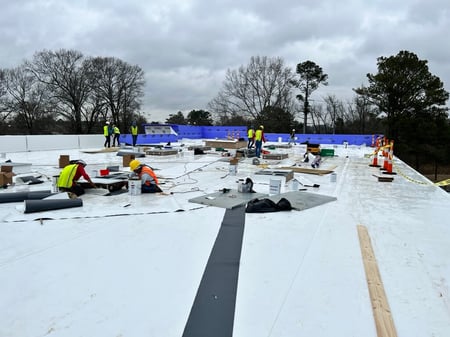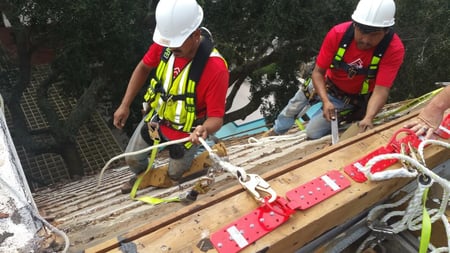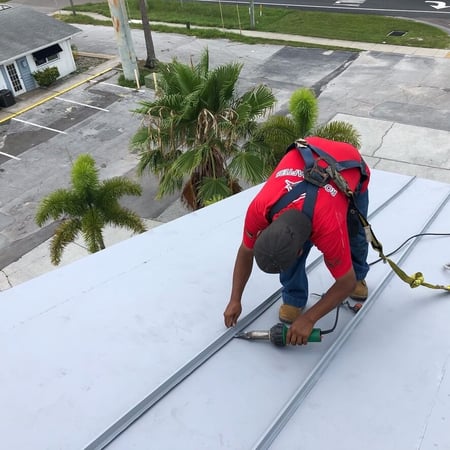Everything You Need to Know About PVC Roof Repair
July , 2024 | 6 min. read

PVC roofing, known for its durability and energy efficiency, is one of the most popular choices for commercial buildings, and for many great reasons! However, like all roofing materials, it can face wear and tear over time. That’s right, all good things must come to an end, and your roof is no exception.
At RoofCrafters, we wish there were a magic spell to make our beloved clients' roofs last forever (and ever), but in the meantime, It’s best I put my cauldron away for now, and provide you with a more modern approach.
That being said, If you're dealing with issues on your PVC roof, you’re not alone, and more importantly, you’re in the right place! This guide will walk you through the process of PVC roof repair, ensuring your roof remains in top condition. Let’s get started, shall we?
Understanding PVC Roofing

PVC, or Polyvinyl Chloride, is a type of single-ply roofing membrane that's been in use since the 1960s. It's highly resistant to chemicals, fire, and water, making it a reliable option for commercial buildings. PVC roofing is also known for its reflective properties, which help in reducing energy costs by keeping buildings cooler.
Common PVC Roof Problems
Before diving into repair methods, it's essential to understand the common issues that might necessitate PVC roof repair. These problems include:
Punctures and tears: Heavy foot traffic, falling debris, or extreme weather conditions can cause punctures and tears in the PVC membrane.
Shrinkage: Over time, PVC roofing can shrink, leading to tension and potential cracks along the seams.
Seam failures: Poor installation or aging can cause the seams of the PVC roof to fail, leading to leaks.
Blistering: Trapped moisture or air beneath the membrane can cause blistering, which can eventually lead to leaks.
DIY PVC Roof Repair: When to Call a Professional

While some minor PVC roof repairs can be handled on a DIY basis, larger issues may require professional intervention. Here’s a quick guide to help you decide:
When to DIY
- Small punctures and tears: If the damage is minor, you can patch it up with a PVC repair kit.
- Regular maintenance: Cleaning the roof and checking for minor issues can be done without professional help.
When to Call a Professional
- Extensive damage: Large punctures, extensive tears, or widespread blistering should be handled by professionals.
- Seam failures: Seam repairs often require specialized equipment and expertise.
- Structural issues: If there are underlying structural problems, a professional assessment is crucial.
Step-by-Step Guide to DIY PVC Roof Repair
If you’ve decided to allow a professional to tackle your PVC problem, good choice! Here’s a step-by-step guide to help you better understand the process:
- Inspect the Roof
Your roofer will start by conducting a thorough inspection of the roof. They’ll look for punctures, tears, blistering, and seam issues, and make a note of all the areas that need attention.
- Clean the Damaged Area
Before repairing, your roofer will clean the damaged area with a soft brush and a mild detergent. This ensures that the patch adheres properly to the membrane. Then, it’s time to rinse the area with water and let it dry completely.
- Cut the Patch
Using a PVC patch material, your roofer will cut a piece that extends at least 2 inches beyond the damaged area on all sides, then, they’ll round off the corners of the patch to prevent peeling.
- Apply PVC Adhesive
The next step is to apply PVC adhesive to both the damaged area and the patch, making sure to follow the manufacturer’s instructions for the adhesive application. Your roofer will let the adhesive become tacky before proceeding.
- Place the Patch
They’ll carefully place the patch over the damaged area, press down firmly, and use a roller to ensure proper adhesion, making sure there are no air bubbles trapped under the patch!
- Seal the Edges
To ensure the patch stays in place, your roofer will seal the edges with a PVC edge sealer. This will prevent water from seeping under the patch and causing further damage in the future.
- Inspect the Repair
After completing the repair, your roofer will conduct one final inspection to make sure that the patched area is secure and watertight. They’ll most likely perform a water test, too, by spraying the repaired section with water and checking for leaks.
Preventative Maintenance for PVC Roofs

Prevention is always the best remedy! Regular maintenance can extend the lifespan of your PVC roof and minimize the need for repairs. Here are some tips to keep your roof in top shape:
Regular Inspections
Schedule bi-annual inspections to catch potential issues early. In the meantime, look for signs of damage, ponding water, and debris buildup.
Clean the Roof
Keep your roof clean by removing debris, dirt, and algae. You can use a gentle cleaner and a soft brush to avoid damaging the membrane.
Address Ponding Water
Ensure proper drainage to prevent ponding water, which can lead to leaks and structural damage. Clean gutters and downspouts regularly to facilitate a healthy water flow.
Protect Against Foot Traffic
Install walk pads to protect the roof from foot traffic, and encourage maintenance personnel to use designated paths to minimize damage.
Trim Overhanging Branches
Trim branches that hang over your roof to prevent damage from falling debris. This also helps reduce the buildup of leaves and organic material.
When to Consider Roof Replacement

I know, I know. We’d all much rather have a simple repair rather than a complete replacement. However, while repairs can extend the life of your PVC roof, there comes a time when replacement is the best option. It may be time to consider roof replacement if you feel like you're constantly repairing your roof, as frequent repairs might indicate that replacement is more cost-effective in the long run.
Additionally, if your PVC roof is aging (typically lasting 20-30 years), it might be time for a new one anyway. Lastly, if there are significant structural problems, replacing the roof can comprehensively address these issues.
Protecting Your PVC Roof
All in all, PVC roof repair is an essential aspect of maintaining your commercial building's integrity and energy efficiency. By understanding common problems, knowing when to DIY or call a professional, and following proper repair and maintenance procedures, you can ensure your PVC roof remains in excellent condition for years to come.
Regular inspections and preventative maintenance are key to minimizing damage and prolonging the life of your roof. Whether you're dealing with minor punctures or considering a full replacement, taking proactive steps will save you time, money, and headaches in the long run.
Remember, a well-maintained PVC roof not only protects your building but also contributes to its overall energy efficiency, making it a smart investment for any commercial property owner. If you’re ready to take the leap and give your PVC a little TLC, be sure to hit that “Schedule an Inspection” button down below!
My name is Cassie, and I’m the Content Manager here at RoofCrafters. I was born and raised in Chicago, Illinois, and made my way out to Florida post-college graduation. I’m incredibly passionate about writing and creating valuable content that helps others with the collaboration of my marketing team. When I’m not working, I enjoy shopping (a little too much), spending time at the beach, and reading!



